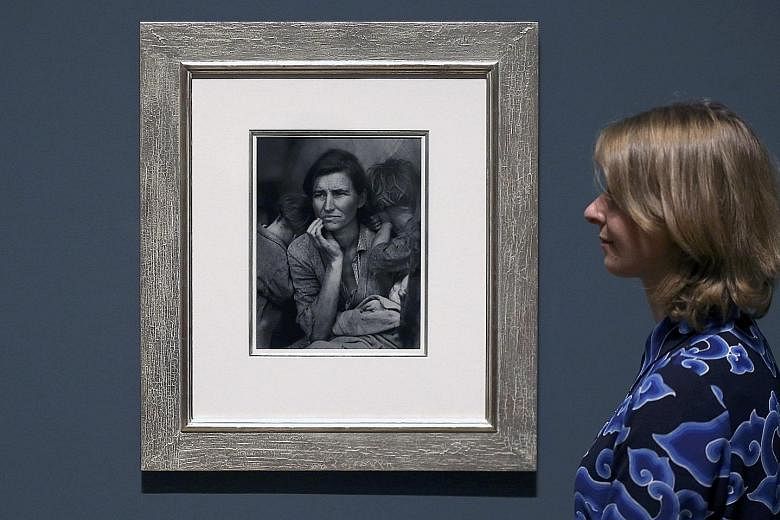LONDON • Elton John famously collects eccentric eyewear. He is less widely known as a collector of photography - and yet the singer-songwriter owns close to 8,000 pieces dating from 1910 to the present.
Highlights from that collection are being shown at Tate Modern in London. For the next six months (through May 7), The Radical Eye presents 191 works from the 1920s to the 1950s by a hit parade of photographers, including Andre Kertesz, Edward Steichen, Man Ray, Irving Penn and Dorothea Lange. (Parts of the collection have been shown at the High Museum of Art in Atlanta in 2000 to 2001 and at the Pinchuk Art Centre in Ukraine in 2007.)
John and David Furnish, his husband and the collection's co-owner, are in talks with Tate over which works they will make available to the national collections as a "gift or promised gift", said Mr Simon Baker, senior curator of photography at Tate Modern.
"This is undoubtedly one of the world's most important collections of photography," said Mr Phillip Prodger, head of photographs at the National Portrait Gallery, who is not involved in the exhibition. "It contains many of the very finest examples of the most famous photographs in the world, particularly in that modern period between the wars."
John began collecting photographs in 1990, shortly after coming out of rehabilitation for alcohol addiction, he said in an interview published in the show's catalogue. While staying with friends in southern France, he attended a photography festival and met a gallerist from Los Angeles who had brought photographs with him.
"I'd never really noticed photography as an art form before," he said. "I looked at them and thought, 'oh my God, these are so beautiful'. I bought about 12 on the spot." The timing "couldn't have been better", he said. "Photographs were very undervalued then."
He began by buying early 20th-century photographs, including some that had caught his eye as a child, and hunted for vintage prints. In 1993, he paid US$193,895 for a print of Man Ray's Glass Tears (1932), the most expensive photograph sold at auction at the time.
"When he found his sobriety, he saw life with new eyes," said Ms Newell Harbin, director of John's collection since 2012. "He realised, going back to when he was a child and looking at posters of these famous photographs, that this was his moment and that he could really start from there."
The Radical Eye is like a crash course in photography: It includes nearly every major photographer from the period and presents their works thematically rather than chronologically. Most of the pictures are in gilded, silver-coated or painted wooden frames made for John in Atlanta, where he has a home.
A room of portraits at the start features photographs by Man Ray of artists Pablo Picasso, Constantin Brancusi and the surrealist poet Andre Breton, among others; there are a total of 25 Man Ray works in the show. The same gallery contains a wall of Irving Penn "corner portraits" - in which famous figures such as actor Spencer Tracy, boxer Joe Louis, composer Duke Ellington and artist Salvador Dali were photographed squeezed into the corner of a room. Elsewhere in the show are significant works such as Paul Strand's Wall Street, New York (1915) and Dorothea Lange's Migrant Mother (1936).
But the exhibition also contains many lesser known gems, such as an image of a winding staircase taken around 1928 by Werner Mantz, or the surrealist stills of Josef Breitenbach.
"The really amazing thing about this collection is the provenance of some of the key works," said Ms Shoair Mavlian, the Tate assistant curator who organised the show with Mr Baker and Ms Harbin. Ms Mavlian said that the tiny image of Kertesz's Underwater Swimmer was the very first contact print made by the artist in 1917, and the 1932 Herbert Bayer photomontage Humanly Impossible (Self-Portrait) was the first print that Bayer painted and which "every subsequent reproduction was made from".
Ms Harbin, who was previously manager of the photography collection at the Art Institute of Chicago, said John collected from all periods, including contemporary, and had recently acquired works by Christopher Williams and Sally Mann. "It has to speak to him," she said. "He doesn't just get that photographer because it has to tick a box."
Mr Prodger said John was "very uncompromising in his collecting and always sought out those examples that thrill when you see them".
"It's incredible not just that he has a print of such and such," he added, "but he has the print."
NYTIMES

